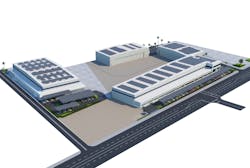As solar costs drop and incentives increase, major airports across the nation are developing renewable energy projects. The airport environment is uniquely suited for solar projects, with panels being installed on roofs and parking canopies that would otherwise offer no financial benefit.
In addition, the Federal Aviation Administration has identified solar energy as a way to reduce airport operating costs and demonstrate commitment to sustainable development. This trend presents a unique opportunity for airport tenants to participate in solar projects that are designed to either save or generate green energy.
Two Types of Solar Projects
Net energy metering is a billing mechanism that provides credit to solar energy system owners for the full retail value of the excess electricity they add to the grid. Representing the majority of airport solar projects, it bases the size of the system on consumption and encourages customers to use the least amount of energy possible. Situations where on-site generation aligns with on-site consumption are the most cost-effective because they limit the amount of electricity that must be purchased from the grid at the retail rate.
While a net metering program pays a utility customer the retail rate for any generation that is fed back into the grid, feed-in tariff rates (also known as FITs) are set above the retail cost of electricity. Basically, these are payments to energy users for the renewable electricity they generate. An FIT program allows the utility to partner with a participant to purchase, under a standard power purchase contract, energy generated from a renewable energy generating system at a fixed price for a term of up to 20 years.
Tenant as Third-Party Host
While airports may construct solar facilities using tax-exempt financing and government grants, tax incentives to encourage capital investments are not readily available. However, as third-party host, an airport business may lease out property to a private developer who constructs and operates the solar installation under a long-term lease agreement. This allows the tenant to generate lease revenue, while the developer monetizes tax credits to sell the renewable energy generated to an off-site customer.
For example, Los Angeles’ Van Nuys Airport (VNY) recently landed its first solar power project to reduce carbon dioxide emissions and shrink its carbon footprint. Consisting of approximately 4,000 panels spanning some 150,000 square feet, the roof-mount/canopy solar electric system will generate approximately 2.5 million kilowatt hours of electricity (enough to power 200 homes) and reduce carbon dioxide emissions by more than 4 million pounds annually. The system’s environmental impact is the equivalent of planting 850 acres of trees and eliminating 6.5 million car miles.
The project resulted from a successful public-private partnership between Aeroplex/Aerolease Group and PCS Energy, the solar provider that leased the roof space and will install the solar panels. Under a power purchase agreement, PCS Energy will supply the Los Angeles Department of Water and Power with 100 percent of the energy produced for the next 20 years. To maximize environmental benefits, PCS will also convert the entire facility to LED lighting, which reduces energy consumption by an additional 35,000 kilowatt hours per year.
The installation of the solar system follows Airport Council International’s recent designation of VNY as the first and only general aviation airport to hold a Level 2 Airport Carbon Accreditation for carbon management and reduction, with the ultimate goal of carbon neutrality. It also marks a first step toward achieving VNY’s future emission reduction goals, which requires third-party engagement by airport tenants, users and operators.
Making the Case for Solar Energy
Clearly, there exists tremendous potential for airports across the nation to implement sustainable energy projects. As airports maximize renewable energy opportunities, they are also supporting public policy goals.
For example, the solar project at VNY supports the City of Los Angeles’ ambitious vision for cutting greenhouse gas emissions, reducing the impact of climate change and building support for national and global initiatives. In fact, the city has already reduced its greenhouse gas emissions by 20 percent below 1990 levels and is nearly halfway to its goal of 45 percent below by 2025.
It also supports the sustainability mission of Los Angeles World Airports to engage its employees, tenants, customers and communities in an effort to continually improve its environmental, economic and social performance. Thus, in addition to economic goals, airport businesses must also consider environmental and social goals when it comes to measuring return on investment for renewable energy projects.
It is no secret that airports in the U.S. have been slow to engage in public private partnerships due to the regulatory environment. In order to receive federal funds, airport owners are required to use revenue from leasing airport property solely for airport purposes. The “tenant as third-party host” model enables municipalities to rely on the private sector for investments in solar and other sustainable energy projects, and to utilize their capital for vital infrastructure projects. The private entity or investor assumes the risk, while the airport reaps a host of environmental and community benefits. This is a public-private partnership at its best.
For airport businesses striving to serve as responsible members of the community, going solar is also as much a social and political decision as it is an economic decision. While they provide vital services to the public, they must also deal with the by-products of jet fuel consumption. The more the aviation community does to offset the airport’s carbon footprint and invest in sustainable energy projects, the more it realizes social and political capital.
In 2016, the National Academies of Sciences, Engineering and Medicine published a report titled “Developing a Business Case for Renewable Energy at Airports” as part of its Airport Cooperative Research Program. Crediting renewable energy projects with providing both financial and public policy benefits, the report explains the importance of aligning green energy projects with an airport’s vision and outlines a decision-making matrix that includes engagement with key stakeholders.
The report concludes that it is only possible for organizations (which have traditionally evaluated solar projects based on available funding and cost benefits) to reach an informed decision by evaluating proposals in terms of financial, self-sustainability, environmental and social benefits.
The community benefits of renewable energy include reduction of greenhouse gases, alleviation of environmental impacts from growth plans, achievement of public policy goals related to environmental protection and the building of positive relationships with airport neighbors.
Solar projects at airports across the nation have taken many different forms. In some cases, green energy has been integrated into new construction projects to demonstrate a commitment to sustainable design. At other airports, a private developer has taken advantage of strong incentives to build and market clean energy projects.
While airport solar projects vary, the positive results are the same. Organizations can make the business case for renewable energy by taking into account economic as well as environmental and social benefits.
Curt Castagna, president and CEO of Aeroplex/Aerolease Group, is a member of the Los Angeles County Airport Commission, president of the Van Nuys and Long Beach Airport Associations, and a board member of the National Air Transportation Association. A certified private and instrument-rated pilot, he has instructed courses in aviation administration at Cal State Los Angeles for over two decades.





